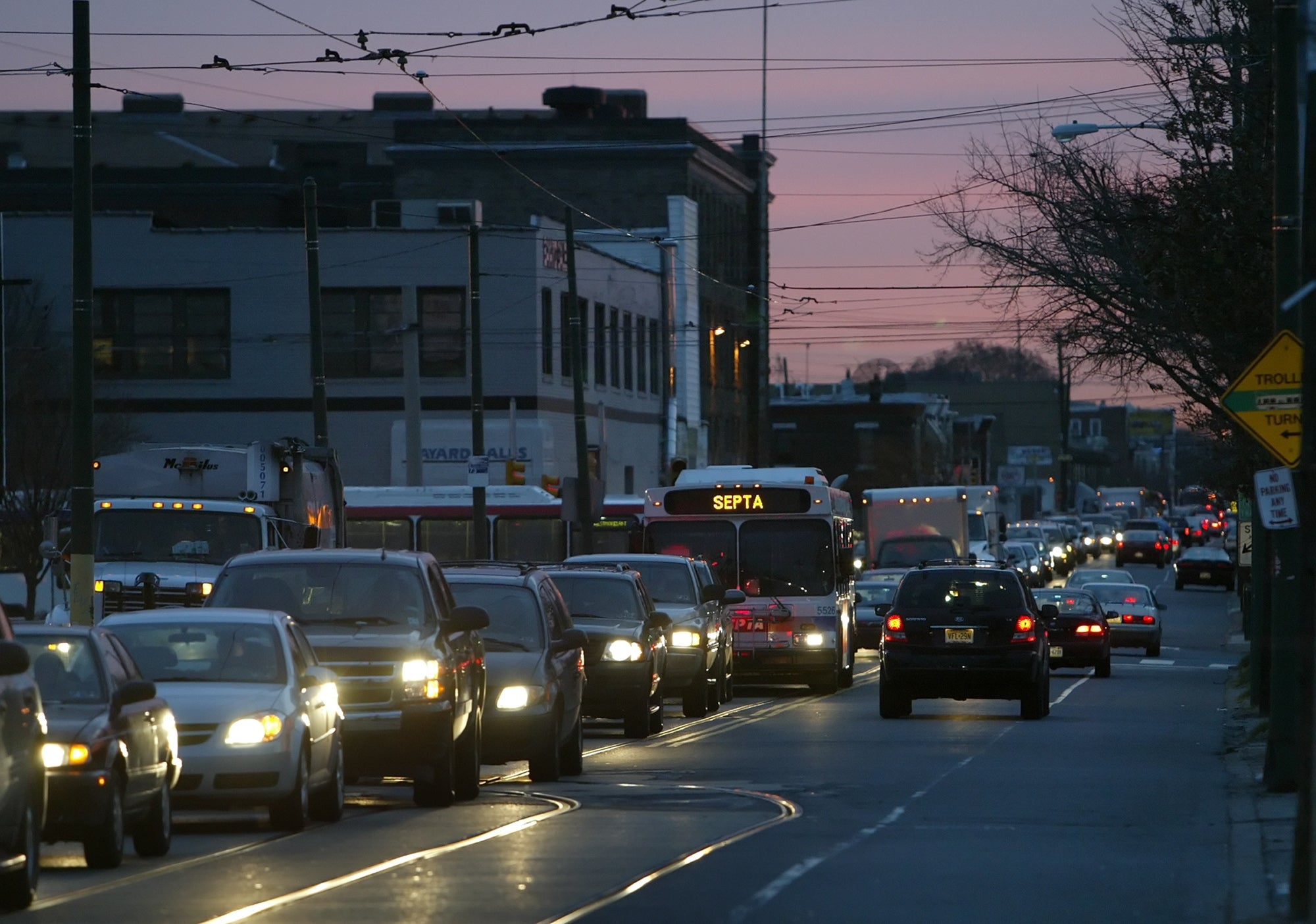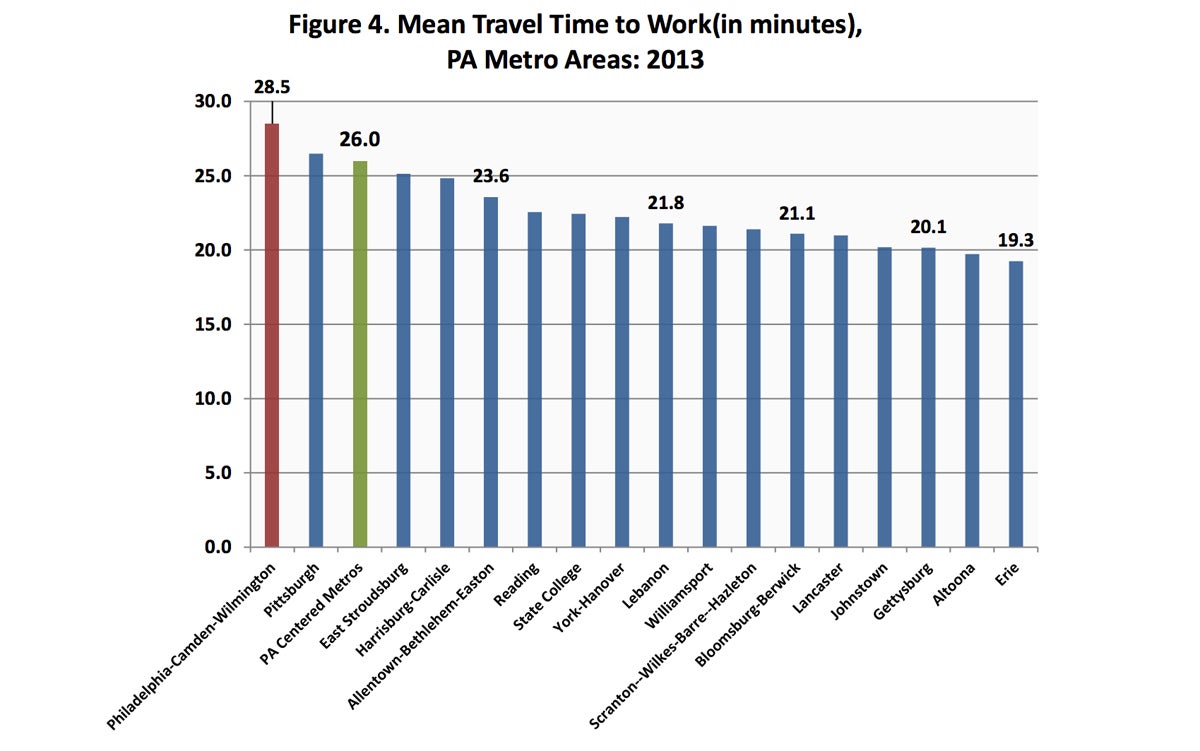Pennsylvania commuters have it easy, researchers say

Commuter traffic in Philadelphia (AP Photo/Joseph Kaczmarek)
Compared to commuters in other states, a larger portion of Pennsylvanians commute alone and have relatively shorter trips to work.
Researchers expected that, according to Penn State Data Center analyst Jennifer Shultz.
What they did not anticipate: Pennsylvania workers seem to have an earlier afternoon commute, compared to other states such as New York, Schultz says.
The overall average commute in Pennsylvania and the US is about the same. But take a closer look at the numbers. They show a larger percentage of Pennsylvania commuters enjoy the very shortest trips, and smaller percentages suffer through longer ones, compared to the U.S. overall.
The Center’s most recent research brief focuses statistics for 18 metropolitan statistical areas across the Commonwealth based on 2013 data from the U.S. Census. Keystone Crossroads also ran the numbers for the seven largest cities proper: Philadelphia, Pittsburgh, Allentown, Bethlehem, Reading, Scranton and Erie.
In many cases, metro-area commutes proved more convenient than those to their core cities.
Here’s how they stacked up:
Convenience
Best: Depends.
More than 5 percent of workers were based at home in the Lancaster and State College metro areas.
Commuters in Erie had the lowest mean commute time, at 19 minutes (versus 25 statewide)
More than 20 percent of people in both Altoona and Williamsport live within 10 minutes of work.
Worst: Philly.
Less than 3 percent work from home. Not the very lowest, but close to it and below the statewide rate.
Average commute to the region is 29 minutes (versus 26 minutes statewide). That adds up to a difference of 25 commuting hours a year.
For commutes to downtown Philly, the average 32 minutes, and longer than an hour for 14 percent of commuters (versus 8 percent statewide and nationally).

Income
Most equitable: Pittsburgh metro area, where commuters’ average incomes fall within $7,000 of one another regardless of the mode of transportation used to get to work.
Least equitable: Reading. The spread is more than $25,000 versus the $9,000 national number.
Noteworthy:
Nationally and statewide, lone commuters tend to have the highest salaries followed by those who take public transportation, and carpoolers make the least.
Exceptions in Pennsylvania: Erie, Reading, Allentown-Bethlehem, Harrisburg-Carlisle and Pittsburgh metro areas. Public transportation riders made the least with carpoolers falling in the middle.
Who carpools?
Not many Gettysburg-area workers (only 6 percent).
Commuters had best vehicle access there, with a high percentage of households with multiple cars (82 percent)
Less than 2percent had no access to a car (lowest).
Lots of people in East Stroudsburg and Erie areas, at 13 and 12 percent, respectively.
Erie area also had lowest proportion of commuters from multi-vehicle households, at 69 percent
And Erie had the lowest with access to at least two cars, versus 75 percent statewide.
• Among cities, carpooling was most popular in Reading (21 percent) and least in Bethlehem (7 percent).
Riding solo
Most: 85 percent of commuters in the Chambersburg area. Highest city proper was Bethlehem at 78 percent, slightly higher than the 77 percent statewide and 76 percent nationally.
Least: 71 percent of commuters in the State College metro area, and less than 50 percent to the city of Philadelphia.
Public transit
Highest use: Philadelphia region (10 percent) and city proper (27 percent). National rate was 9 percent; in Pennsylvania, 8 percent.
Half of metro areas reported 1percent or fewer commuters using public transportation. Lowest were Lebanon, Altoona and Chambersburg.
Among cities, lowest was 2.5 percent in Scranton.
And, oddly, motorcycles aren’t counted in the same group as cars and trucks – but instead with taxis and other options. Shultz says that’s because so few people reported driving them.
WHYY is your source for fact-based, in-depth journalism and information. As a nonprofit organization, we rely on financial support from readers like you. Please give today.



